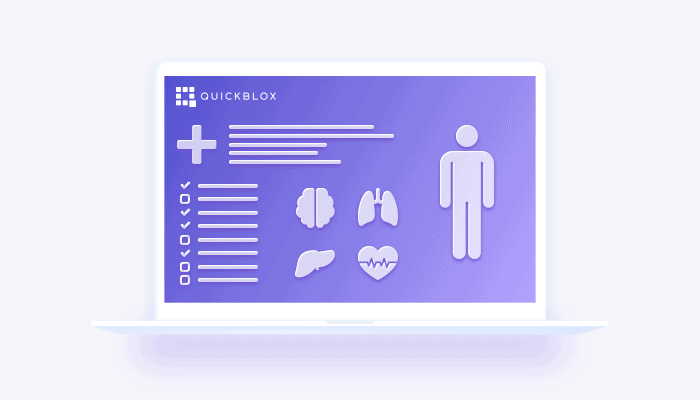
Electronic medical records (EMR) and Electronic health records (EHR) solutions are a crucial part of managing patient records in medical clinics and hospitals all over the world.
Medical records are patient-specific clinical information collected by clinicians to be used by healthcare service providers for diagnosis, treatment, and follow-up.
EMR and EHR solutions are designed to manage patient records in a central secure environment. Their primary goals are to:
- Provide accurate, updated information about patients
- Securely share private records among clinicians
- Ensure prompt information access that allows doctors to make informed time-sensitive decisions
- Reduce the cost of paperwork
The limitations of web-based desktop-accessible EMR/EHR
EMR and EHR systems share similar functionalities. They are multi-user systems, relied upon by doctors, nurses, specialists, and administrators. In theory, they support multiple terminals like desktops, laptops, tablets, and handheld mobile devices. However, generally built as web-based applications the degree to which they are accessible and fully functional via handheld devices varies.
Doctors access their computers to search for, add to, or create a patient’s record. The dependence on a predominantly web-based desktop application is problematic, however, as doctors tend to be highly mobile in clinics and hospitals, working at various work stations, examination rooms, and departments. This means that they are not always in the range of the EMR/EHR system they need to access and rarely do these systems use the full capabilities of mobile devices.
Efforts made to build custom mobile apps for certain EMR/ EHR systems have fallen short. It’s not that easy for these established software systems to take advantage of the built-in device features of new mobile phones and tablets. Many of these systems are old and it becomes difficult to extend them without compromising the base-code.
QuickBlox offers a viable solution to this problem.
Why QuickBlox?
QuickBlox is a communication platform as a service (PaaS), which offers real-time text messaging and video calling, as well as a conferencing infrastructure with multiple SDKs. It enables developers to build independent messaging apps or to integrate QuickBlox messaging functionalities into existing functional apps.
Using QuickBlox SDKs provides a hustle-free approach for developers to build QuickBlox based-apps or extend an existing system with QuickBlox features.
What Does QuickBlox provide?
- Data centralization
A centralized data store allows developers to connect several apps using QuickBlox infrastructure. It also helps to analyze activities and build apps, plugins, and widgets with ease.
- Privacy
User and patient records are secure and private in the cloud. Also, QuickBlox offers to disable history option for developers which can be beneficial for low-footprint communication.
- Real-time Instant Messaging
Instant messaging is the core functionality of QuickBlox. It can be implemented easily using any of the available QuickBlox SDKs.
- Video calling and conferencing
High-definition video calling and conferencing with mobile and multiple resolution support is yet another amazing advantage that QuickBlox offers.
- File sharing
Quickblox provides file and media-sharing, which benefits doctors and patients alike enabling the sharing of crucial patient-specific files like medical imaging files and lab reports.
- Multiple development SDKs
Developers can choose the right SDK to build web, desktop, or mobile apps. They can also use JavaScript SDK to extend web and JavaScript apps as everything is ready and set.
- Mobile-oriented apps with help of mobile SDKs
Flutter, React Native, Native Android, iOS SDKs, and REST-API
- Multiple deployment options
Enterprises can choose where to deploy their system from platforms including AWS, IBM Cloud, Microsoft Azure, and Digital Ocean. Deployment on-premise is also an option.
Benefits of Integrating QuickBlox into EMR/ EHR systems
- Portability:
In the clinical environment, clinicians and nurses are encouraged to use their own mobile devices, known as BYOD (bring your own device).
These healthcare professionals depend on their mobiles as a primary communication channel, especially when they are not fixed at one clinic all the time.
Through integration with QuickBlox, they are able to enjoy easy access to reactive EMR-QuickBlox apps directly on their mobile.
QuickBlox helps to extend EMR programs to take full advantage of mobile devices that transform any EMR/ EHR into a real-time reactive platform.
QuickBlox SDKs are mobile-ready. QuickBlox has native mobile SDKs for iOS and Android developments, React Native SDK, Flutter SDK which is trending nowadays, and JavaScript SDK.
- Share medical records among clinicians:
Medical staff can share patient medical records internally without sending them to any third-party service like emails or non-compliant messaging software (WhatsApp or Telegram).
Sharing records, exchanging notes, and files from within the system are possible with QuickBlox.
QuickBlox also offers multiple file-formats sharing which can be medical tests, radiology images, PDF files, or video files.
- Real-time communication:
Instant communication among medical teams increases the efficiency and quality of the healthcare service. It saves time and improves patient experience and satisfaction.
Real-time communication helps doctors to make an informed decision at the right time which benefits the patient and improves the quality of healthcare services provided.
- Compliant:
HIPAA and GDPR compliance are important for many healthcare-related services in the USA and EU. But with QuickBlox there is no need to worry, as it has been used to build dozens of apps that comply with HIPAA and GDPR. QuickBlox also offers HIPAA-specific implementation services for hospital and patient-related legal services.
How can developers implement QuickBlox into EMR/ EHR?
Most of the EMR/ EHR solutions are web applications that users like doctors and nurses can access through any web browser for desktop or mobile.
To integrate QuickBlox functionalities with EMR without messing with its coding structure developers have two options:
- Web Widget
The web widget is a small tiny application that can be embedded as an element of the host web page, but it is independent in functionality and structure from the host app.
As an example, a chat widget or a contact form widget can be embedded in a static website. It does not use the coding or the resources of the host page and work independently of it.
Developers tend to build web widgets using JavaScript. With technologies like Vue, React, and Polymer, widgets are straightforward to create.
QuickBlox offers a fully packed JavaScript SDK that is compatible with Vue, React, and Polymer.
- REST-API
QuickBlox server REST-API includes the same functionalities as other QuickBlox SDKs.
Developers can extend the EMR/ EHR solutions directly by adding custom workflow logic and views with QuickBlox REST-API.
End note
Adding real-time messaging to EMR systems may require dramatic changes to the core code. However, with QuickBlox it’s possible to extend EMR/ EHR solution functionalities hustle-free without needing support from the core developers.






